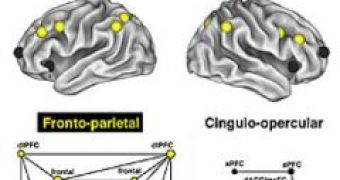The double personality may not be a myth, as neuroscientists have found that the command bridge of our body, the brain, harbors two commanders, not one. The team at Washington University School of Medicine in St. Louis, found that in the brain these two captains are networks of brain nuclei that do not consult each other but still function toward a common hint: voluntary controlled, goal-oriented behavior, from reading a word or singing a song to searching for a star, omitting involuntary behaviors like control of the pulse rate or digestion.
"This was a big surprise. We knew several brain regions contribute to top-down control, but most of us thought we'd eventually show all those regions linking together in one system, one little guy up top telling everyone else what to do," said senior author Dr. Steven Petersen, James S. McDonnell Professor of Cognitive Neuroscience and professor of neurology and psychology.
This discovery could explain better the effects of brain injury, for future treatments.
"For example, on rare occasions patients with brain injuries will develop behaviors that are stimulus-bound: Every time they encounter a particular stimulus, they respond exactly the same way. One man with a brain injury started undressing everytime he saw a bed, regardless of whether it was in a furniture store or his own bedroom. This research may help us understand what's happening to these patients." explained first author Nico Dosenbach, a Ph.D. student.
The same team found that just one stimulus (for example, seeing the printed word "dog") can induce in the brain many different things (read it aloud, create a mental picture of a dog or a list of linked verbs). They detected 39 brain regions that are consistently turned on before the brain is going to accomplish a task, using functional magnetic resonance imaging (MRI) scans.
Now, the researchers employed a different brain scanning technique, called resting state functional connectivity MRI. Subjects were asked to relax while their brains were scanned instead of working on a task. Variations in MRI scan took place even when subjects were idle. The team also used graph theory, that visually graphs links between pairs of objects. "A similar approach is used in the party game Six Degrees of Kevin Bacon. You use paired connections - appearances in the same movie, marital relationships - to go from one actor or actress to another until you've identified a chain of connections linking Kevin Bacon and another performer that wasn't immediately obvious." said Petersen.
Resting state functional connectivity MRI detected pairs of brain regions activated and disabled roughly in synch with each other, pointing they were likely functioning together. The researcher drafted a line between paired brain regions when their functioning patterns correlated tightly enough.
"You might expect that everything is connected to everything, and you would get sort of a big mess and not much information. Even at low levels of correlation, there were two sides to these graphs. Brain regions on either side had multiple connections to other regions on their side, but they never connected to regions on the opposite side." said Dosenbach.
Stable systems independently controlled by two or more masters are a common pattern in biology, ecology, economics, computer science, sociology and other disciplines. One example is body temperature regulation, involving several independent factors like sweat glands, metabolism and activity level. When one controlling factor is impaired, others are able to compensate for it.
One of the brain networks, called the cinguloopercular network, was connected to a "sustain" signal.
"When you start doing a task, this signal turns on. It stays constant while you're doing the task, and then when you're done it turns off." said Petersen.
The other network, the frontoparietal, was consistently active at the beginning of mental tasks and during the error correction.
"This maps very nicely onto another idea that's common in network dynamics and adaptive systems. This is the idea that the factors controlling adaptive systems often act on different time scales. We think the frontoparietal network may be the more online, rapid-adapting controller, while the cinguloopercular network is the more stable, set, in-the-background controller." said Dosenbach.
But this doesn't imply the cinguloopercular network works very rigidly.
"It just does that on a slower time scale, to make sure you don't needlessly throw out all the work you've already done. It's amazing: on the one hand, the brain can be very flexible and rapidly adapt to changing feedback, but it can also lock in on something and tune out distractions until the task is finished. And these two separate control systems that work toward the same goal without actually talking to each other likely help create this powerful flexibility." said Dosenbach.
The team will expand their research on more brain regions involved to control and it will also look for differences in the brain networks in subjects from different age groups or with brain injuries or disabilities.

 14 DAY TRIAL //
14 DAY TRIAL //